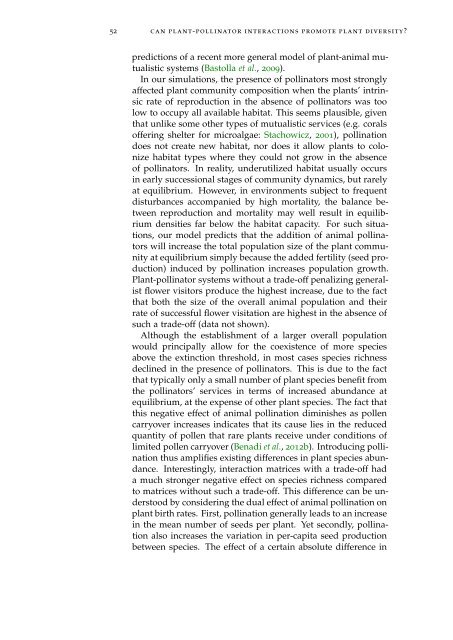Linking Specialisation and Stability of Plant ... - OPUS Würzburg
Linking Specialisation and Stability of Plant ... - OPUS Würzburg
Linking Specialisation and Stability of Plant ... - OPUS Würzburg
You also want an ePaper? Increase the reach of your titles
YUMPU automatically turns print PDFs into web optimized ePapers that Google loves.
52 can plant-pollinator interactions promote plant diversity?<br />
predictions <strong>of</strong> a recent more general model <strong>of</strong> plant-animal mutualistic<br />
systems (Bastolla et al., 2009).<br />
In our simulations, the presence <strong>of</strong> pollinators most strongly<br />
affected plant community composition when the plants’ intrinsic<br />
rate <strong>of</strong> reproduction in the absence <strong>of</strong> pollinators was too<br />
low to occupy all available habitat. This seems plausible, given<br />
that unlike some other types <strong>of</strong> mutualistic services (e.g. corals<br />
<strong>of</strong>fering shelter for microalgae: Stachowicz, 2001), pollination<br />
does not create new habitat, nor does it allow plants to colonize<br />
habitat types where they could not grow in the absence<br />
<strong>of</strong> pollinators. In reality, underutilized habitat usually occurs<br />
in early successional stages <strong>of</strong> community dynamics, but rarely<br />
at equilibrium. However, in environments subject to frequent<br />
disturbances accompanied by high mortality, the balance between<br />
reproduction <strong>and</strong> mortality may well result in equilibrium<br />
densities far below the habitat capacity. For such situations,<br />
our model predicts that the addition <strong>of</strong> animal pollinators<br />
will increase the total population size <strong>of</strong> the plant community<br />
at equilibrium simply because the added fertility (seed production)<br />
induced by pollination increases population growth.<br />
<strong>Plant</strong>-pollinator systems without a trade-<strong>of</strong>f penalizing generalist<br />
flower visitors produce the highest increase, due to the fact<br />
that both the size <strong>of</strong> the overall animal population <strong>and</strong> their<br />
rate <strong>of</strong> successful flower visitation are highest in the absence <strong>of</strong><br />
such a trade-<strong>of</strong>f (data not shown).<br />
Although the establishment <strong>of</strong> a larger overall population<br />
would principally allow for the coexistence <strong>of</strong> more species<br />
above the extinction threshold, in most cases species richness<br />
declined in the presence <strong>of</strong> pollinators. This is due to the fact<br />
that typically only a small number <strong>of</strong> plant species benefit from<br />
the pollinators’ services in terms <strong>of</strong> increased abundance at<br />
equilibrium, at the expense <strong>of</strong> other plant species. The fact that<br />
this negative effect <strong>of</strong> animal pollination diminishes as pollen<br />
carryover increases indicates that its cause lies in the reduced<br />
quantity <strong>of</strong> pollen that rare plants receive under conditions <strong>of</strong><br />
limited pollen carryover (Benadi et al., 2012b). Introducing pollination<br />
thus amplifies existing differences in plant species abundance.<br />
Interestingly, interaction matrices with a trade-<strong>of</strong>f had<br />
a much stronger negative effect on species richness compared<br />
to matrices without such a trade-<strong>of</strong>f. This difference can be understood<br />
by considering the dual effect <strong>of</strong> animal pollination on<br />
plant birth rates. First, pollination generally leads to an increase<br />
in the mean number <strong>of</strong> seeds per plant. Yet secondly, pollination<br />
also increases the variation in per-capita seed production<br />
between species. The effect <strong>of</strong> a certain absolute difference in
















